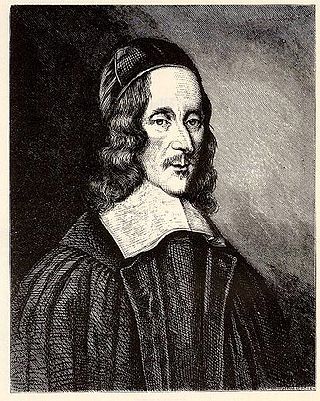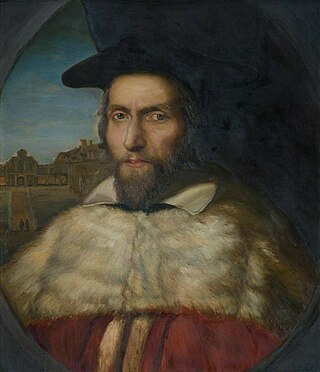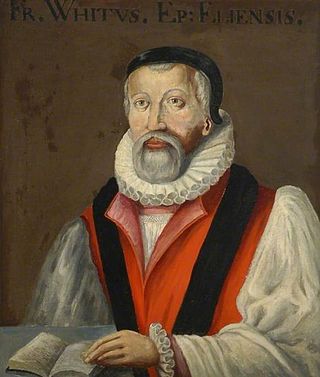Related Research Articles

George Herbert was an English poet, orator, and priest of the Church of England. His poetry is associated with the writings of the metaphysical poets, and he is recognised as "one of the foremost British devotional lyricists." He was born in Wales into an artistic and wealthy family and largely raised in England. He received a good education that led to his admission to Trinity College, Cambridge, in 1609. He went there with the intention of becoming a priest, but he became the University's Public Orator and attracted the attention of King James I. He sat in the Parliament of England in 1624 and briefly in 1625.

John Cosin was an English churchman.

Richard Neile was an English churchman, bishop successively of six English dioceses, more than any other man, including the Archdiocese of York from 1631 until his death. He was involved in the last burning at the stake for heresy in England, that of the Arian Edward Wightman in 1612.

Francis White was an English bishop and controversialist.
This is a list of people who have served as Lord Lieutenant of Durham.
Richard Montagu was an English cleric and prelate.
John Blakiston, was a member of the English parliament, one of the regicides of King Charles I of England, a prominent mercer and coal merchant, puritan and anti-Episcopalian.

The Caroline Divines were influential theologians and writers in the Church of England who lived during the reigns of King Charles I and, after the Stuart Restoration, King Charles II. There is no official list of Caroline-era divines; they are defined by the era in which they lived, and Caroline Divines hailed from England, Ireland, Scotland, and Wales. However, of these four nations, it is Caroline England which is most commonly considered to have fostered a golden age of Anglican scholarship and devotional writing, despite the socio-cultural upset of civil war, regicide, and military rule under Oliver Cromwell. Importantly, the term divine is restricted neither to canonised saints nor to Anglican figures, but is used of many writers and thinkers in the wider Christian church.

Laudianism was an early seventeenth-century reform movement within the Church of England, promulgated by Archbishop William Laud and his supporters. It rejected the predestination upheld by the previously dominant Calvinism in favour of free will, and hence the possibility of salvation for all men. It is probably best known for its impact on the Anglican high church movement and its emphasis on liturgical ceremony and clerical hierarchy. Laudianism was the culmination of the move towards Arminianism in the Church of England, but was neither purely theological in nature, nor restricted to the English church.
Thomas Jackson was an English theologian, and President of Corpus Christi College, Oxford. Originally a Calvinist, he became in later life an Arminian.

Richard Frankland (1630–1698) was an English nonconformist, notable for founding the Rathmell Academy, a dissenting academy in the north of England.
Augustine Lindsell was an English classical scholar and Bishop of Hereford. In church matters he was advanced by Richard Neile, and was a firm supporter of William Laud. As a scholar he influenced Thomas Farnaby.

Peter Smart (1569–1652?) was an Anglican Puritan clergyman, kept imprisoned for 12 years after he preached against innovations in the ceremonies at Durham Cathedral.
Daniel Cawdry (Cawdrey) (1588–1664) was an English clergyman, member of the Westminster Assembly, and ejected minister of 1662.
Barnabas Oley (1602–1686) was an English churchman and academic. A royalist figure of the First English Civil War, he was also the first editor of George Herbert and Thomas Jackson, and a personal friend of Nicholas Ferrar. In old age he was archdeacon of Ely for a year.
Denis Granville was an English non-juring cleric, Dean of Durham and then Jacobite exile.
Sir Gilbert Gerard, 1st Baronet of Fiskerton was an English soldier and politician. During the English Civil War he supported the Royalist cause. After the Restoration he sat in the House of Commons from 1661 to 1685.
Sir Paul Neile FRS was an English astronomer and politician who sat in the House of Commons in 1640 and from 1673 to 1677.
John Duncumb was an English clergyman and antiquary. He is best known as the author of an unfinished county history of Herefordshire.
Richard Watson was a Church of England clergyman, Royalist divine, controversialist, and poet.
References
- Attribution
![]() This article incorporates text from a publication now in the public domain : Goodwin, Gordon (1888). "Duncon, Eleazar". In Stephen, Leslie (ed.). Dictionary of National Biography . Vol. 16. London: Smith, Elder & Co. pp. 181, 182.
This article incorporates text from a publication now in the public domain : Goodwin, Gordon (1888). "Duncon, Eleazar". In Stephen, Leslie (ed.). Dictionary of National Biography . Vol. 16. London: Smith, Elder & Co. pp. 181, 182.